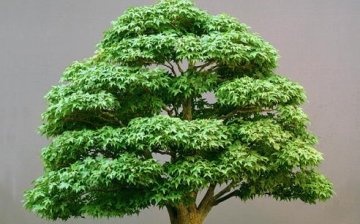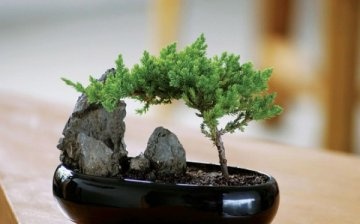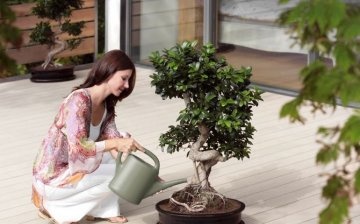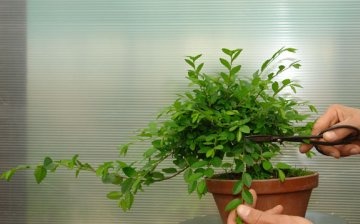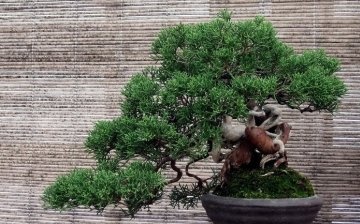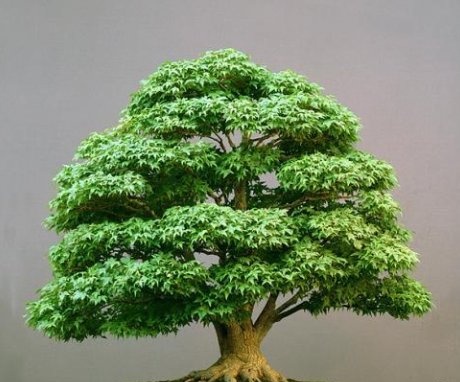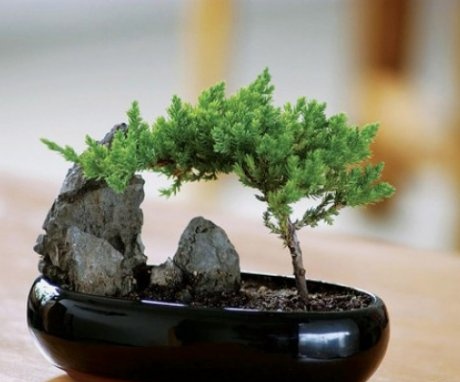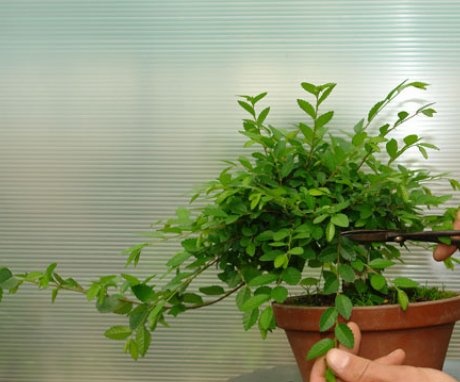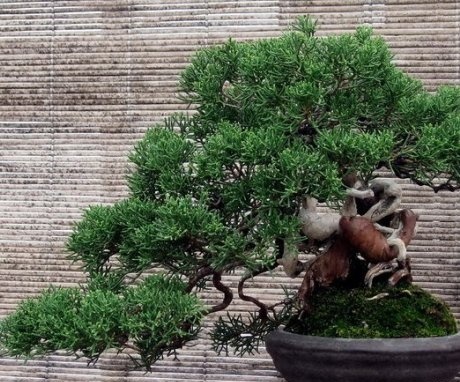The best species and styles of bonsai
The technique of cultivating miniature trees originated in China over a thousand years ago. Bonsai literally translates to "plant on a tray". This technique came to Japan with Buddhist monks, who used small trees to decorate niches of houses, so the plants were no more than 50 cm.And in the 18th century, the Japanese turned this technique into a real art, in connection with which a variety of styles arose bonsai.
Bonsai can be bought, but the pleasure is not cheap. Therefore, more and more often, flower growers independently practice the cultivation of such trees. In order for the undertaking to be crowned with success, you must first decide on the type of plants suitable for growing on a "tray".
Content:
- Bonsai species diversity
- How to grow a tree in miniature at home
- Taking proper care of your bonsai
- Crown formation rules
- What are the styles of bonsai
Bonsai species diversity
The species diversity of bonsai is extensive, but it is recommended for beginner growers to start with conifers, because they are long-livers and quite unpretentious.
There are several main types of bonsai that combine certain types of plants:
- evergreens that delight with rich greens at any time of the year
- spring blooming, which bloom in the spring months
- blooming in summer
- capable of throwing flowers only in autumn
- with an intricate shape of the trunk and branches that open to the eye after falling leaves
Any plant can be used for bonsai, but thermophilic trees and shrubs should be chosen for indoor floriculture. Most often in apartments and offices you can admire the following views:
- dwarf pomegranate
- Ixora
- acacia
- bougainvillea
- fatty silver
- junipers
- pine trees, thuami or firs
- fruit representatives of the garden, among which there are cherry, apple tree or pear
- birches
- oak trees
Some craftsmen also practice more finicky representatives of green nature to create bonsai. For inexperienced craftsmen who decide to grow a miniature forest or garden in the house, any seeds of undemanding plants are suitable. Wisteria is often used, the small flowers of which densely cover the branches and make the plant very decorative.
How to grow a tree in miniature at home
The secret to making a small copy of a garden tree is to keep the crown pruned. In order to grow bonsai from seeds at home, you will need a lot of patience and a lot of desire. On the first try, it may not work out, so you have to start all over again.
The process of growing a miniature plant is quite long and requires constant attention.
Conventionally, the technique of cultivating bonsai can be divided into three main stages:
- Seed care for an extended period of time, which can take years. The plant should be chosen taking into account the climatic conditions of the region. Ficus and pine are considered the most adapted.
- Taking care of the sprout. The most crucial moment that requires unremitting attention. A young plant needs to be ventilated frequently. And when four full-fledged leaves appear, the sprout should be transplanted and after two months it should be introduced feeding... In winter, it is advisable to move the plant to the windowsill, and gradually reduce the fertilizing to nothing.
- Maintenance of an adult tree. It is necessary to constantly monitor the degree of illumination and maintain an optimal level of humidity through periodic spraying. After a certain period of time, they begin form a crown bonsai.
It is important for little green friends to create optimal conditions, especially in the early stages of growth. To do this, you should study the characteristics and preferences of the chosen culture and satisfy all its whims.
Taking proper care of your bonsai
The secret of the decorativeness of bonsai is that the trees need to be grown in a permanent container, periodically pruning the crown and roots. Thanks to such segments, the balance of the ground and underground parts of the plant is achieved, and the desired crown is also formed. In addition to pruning, other, equally important, cultivation conditions should be taken into account.
Care Tips:
- Accommodation. If you choose the right type of plant, then you can grow it both indoors and outdoors. The main thing is to provide a sufficient amount of light and periodic ventilation. It should also be remembered that some cultures have a rest period. These include decorative maple or Pine... Some types of plants should first be kept indoors and then transplanted into the garden. Experienced gardeners argue that there are no completely street crops, because if a plant is placed in a room and the necessary conditions are created, then they will gradually acclimate and grow no worse than on the street.
- The choice of capacity for soil preparation. The bonsai technique involves the use of light soils with good cultivation capacity. Water stagnation should not be allowed, so you need to equip the container with high-quality drainage. The containers are selected very different, but to create creative compositions, containers of different geometric shapes are often taken. The main thing is that they are not deep - this will allow root system develop correctly. In this case, you need to ensure that the color of the container is in harmony with the color of the plant itself.
- Watering. Proceeding from the fact that the size of the container is rather limited, certain methods of irrigation of such plants have been developed. This is either direct watering or placing the bonsai pot in a container of water. The frequency of irrigation depends on the chosen crop: some plants can easily tolerate periods of drought, while others require constant moisture. If you do not take into account the preferences of bonsai, then the root system can be damaged, leading to death. It is better to water miniature trees with rainwater, but tap water is also suitable if it is cleaned and allowed to settle. The temperature of the irrigation water should be close to the air temperature.
- Also, plants need spraying to maintain the required moisture level. Such events are held several times a day in the summer. The procedures allow the plant not only to freshen up, but also wash off dust particles from the leaves.
- Bonsai should be fed once every 7-10 days. For this, any garden fertilizers are used: urea, sapropel and others. algae-based dressings are also applied, but twice less often. Top dressing provides nutrition and strengthens the culture by replenishing nutrients in the soil.Top dressing is applied in the form of powders, granules or solution.
But when feeding, you should adhere to several basic rules:
- at the initial stages of development, fertilizers with a low nitrogen content are used - they significantly accelerate growth
- a high nitrogen concentration is permissible with mature leaves, when the first wave of growth has begun to decline
- in spring and autumn, it is customary to use complex balanced fertilizers. Plants with periods of sleep, stop feeding before the onset of cold weather
Avoid feeding if the bonsai is sick, weakened, or just transplanted.
Crown formation rules
To reduce the size of the plant, you can use various methods:
- Seasonal pruning, which is the key to success in growing, but it must be done correctly, otherwise the plant will die.
- Direction of growth of branches and trunk using copper or aluminum wire.
- By creating the illusion of an old tree. To do this, remove the bark from the trunk of a living tree. But this must be done extremely carefully so as not to destroy the plant.
Pruning is the main method of crown formation. It allows you to reduce the size of the tree, form the location of the main branches, and also stimulate the growth of young shoots. But with such events, bonsai is experiencing heavy loads, so manipulations can only be carried out on healthy and strong specimens.
Several types of pruning are used when forming bonsai:
- forming, when large branches are cut out and the trunk is truncated, creating the shape of the future plant
- shortening branches, which allows you to increase the volume and give a neat look
- easy cutting of young shoots
- pinching to limit growth
- root trimming - for the growth of a new root mass
Moreover, pruning of roots and crowns should be proportional and balanced.
What are the styles of bonsai
Interest in the bonsai technique prompted gardeners and breeders to a number of experiments, thanks to which the style of this method of growing plants was formed. Today there are quite a few styles of bonsai, including:
- "Chokkan" is presented in a classic upright style with simple and clear lines. This is the style that beginners prefer.
- "Shakkan" - is expressed in a tilted tree.
- "Sokkan" has a forked trunk.
- "Moegi" is distinguished by a peculiar irregular trunk, but the top of the crown is directed vertically.
- "Fukinagashi" looks like a tree bent in half, the trunk of which is parallel to the ground.
- Group plantings that depict a miniature grove.
- "Kengai" growing in a cascade.
Also apply styles growing in a stone tree or with a bare root system. But before choosing a certain style, you should find out from experienced florists the nuances of their formation and cultivation. Only after consultation will it become clear how difficult it is to grow such beauty.
Bonsai is not only beautiful miniatures, it is a corner of wildlife in a confined space (room or house).
The presence of such a living corner is always able to instill joy and good mood in the soul, calm the shattered nervous system and minimize family discord. The presence of bonsai, as it were, reminds us that a person is a piece of pristine nature, which modern people have long forgotten, being in constant pursuit of technical progress.
More information can be found in the video:




